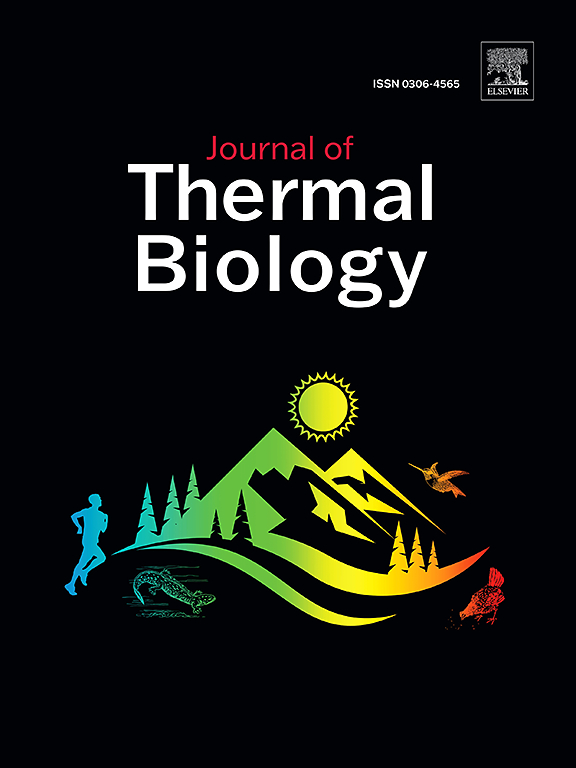Temperature-dependent sleep patterns in Drosophila
IF 2.9
2区 生物学
Q2 BIOLOGY
引用次数: 0
Abstract
Sleep is a fundamental physiological process conserved through evolution, from worms to humans. Understanding how temperature influences sleep is essential for comprehending the complexities of animal behavior, physiology, and their adaptations to thermal environments. This study explores the impact of temperature on sleep behavior and patterns in Drosophila melanogaster. Through a comprehensive analysis, we assessed how temperatures during development and adulthood affect sleep duration and fragmentation. Our results show that exposure to non-optimal temperatures increases overall sleep duration, primarily by extending daytime sleep. Sleep patterns were also substantially modulated by developmental temperature. Flies that developed at 29 °C exhibited longer sleep durations compared to those that developed at either 19 °C or 25 °C. In general, sleep was more prevalent than wakefulness under most conditions, particularly at non-optimal temperatures. At intermediate temperatures, sleep became more fragmented and episodes shorter. The interplay between sleep and wakefulness varied depending on both population and developmental temperature. Developmental and adult temperatures also influenced sleep latency, the time it takes to fall asleep. Interestingly, the impact of temperature on daytime sleep latency differed among populations, whereas nighttime sleep latency consistently increased with temperature for all groups. Flies that developed at 29 °C showed shorter sleep latencies than those from other temperatures, both during the day and night. Finally, a strong negative correlation was observed between total sleep duration and daily locomotor activity across all groups and temperatures. These findings underscore the critical role of environmental temperature in regulating sleep behavior in Drosophila, with potential implications for understanding temperature-dependent sleep mechanisms in other organisms.
果蝇的温度依赖睡眠模式。
从蠕虫到人类,睡眠是进化过程中保存下来的基本生理过程。了解温度如何影响睡眠对于理解动物行为、生理及其对热环境的适应的复杂性至关重要。本研究探讨温度对黑腹果蝇睡眠行为和模式的影响。通过综合分析,我们评估了发育和成年期间的温度如何影响睡眠持续时间和碎片化。我们的研究结果表明,暴露在非最佳温度下会增加整体睡眠时间,主要是通过延长白天睡眠时间。睡眠模式也在很大程度上受到发育温度的调节。与在19°C或25°C条件下发育的果蝇相比,在29°C条件下发育的果蝇睡眠时间更长。总的来说,在大多数情况下,尤其是在非最佳温度下,睡眠比清醒更普遍。在中等温度下,睡眠变得更加碎片化,睡眠时间更短。睡眠和清醒之间的相互作用取决于种群和发育温度。发育期和成年期的体温也会影响睡眠潜伏期,即入睡所需的时间。有趣的是,温度对白天睡眠潜伏期的影响在人群中有所不同,而夜间睡眠潜伏期随着温度的升高而持续增加。在29°C环境下发育的果蝇比在其他温度下发育的果蝇表现出更短的睡眠潜伏期,无论是白天还是晚上。最后,在所有组和温度中观察到总睡眠时间与日常运动活动之间存在强烈的负相关。这些发现强调了环境温度在调节果蝇睡眠行为中的关键作用,对理解其他生物的温度依赖睡眠机制具有潜在的意义。
本文章由计算机程序翻译,如有差异,请以英文原文为准。
求助全文
约1分钟内获得全文
求助全文
来源期刊

Journal of thermal biology
生物-动物学
CiteScore
5.30
自引率
7.40%
发文量
196
审稿时长
14.5 weeks
期刊介绍:
The Journal of Thermal Biology publishes articles that advance our knowledge on the ways and mechanisms through which temperature affects man and animals. This includes studies of their responses to these effects and on the ecological consequences. Directly relevant to this theme are:
• The mechanisms of thermal limitation, heat and cold injury, and the resistance of organisms to extremes of temperature
• The mechanisms involved in acclimation, acclimatization and evolutionary adaptation to temperature
• Mechanisms underlying the patterns of hibernation, torpor, dormancy, aestivation and diapause
• Effects of temperature on reproduction and development, growth, ageing and life-span
• Studies on modelling heat transfer between organisms and their environment
• The contributions of temperature to effects of climate change on animal species and man
• Studies of conservation biology and physiology related to temperature
• Behavioural and physiological regulation of body temperature including its pathophysiology and fever
• Medical applications of hypo- and hyperthermia
Article types:
• Original articles
• Review articles
 求助内容:
求助内容: 应助结果提醒方式:
应助结果提醒方式:


